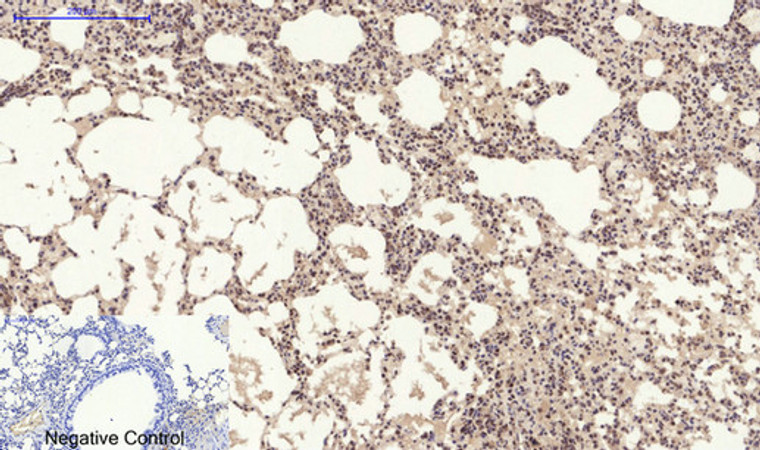-
Western blot analysis of lysates from COS7, Jurkat cells, treated or untreated with TNFa, (Green) primary antibody was diluted at 1:1000, 4°C over night, secondary antibody was diluted at 1:10000, 37°C 1hour. (Red) loading contrl antibody was diluted at 1:5000 as loading control, 4°C over night, secondary antibody was diluted at 1:10000, 37°C 1hour.
-
Immunohistochemistry analysis of paraffin-embedded human breast carcinoma, using STAT3 (Phospho-Ser727) Antibody. The picture on the right is blocked with the phospho peptide.
-
Western blot analysis of lysates from COS7 cells, using STAT3 (Phospho-Ser727) Antibody. The lane on the right is blocked with the phospho peptide.
-
Western blot analysis of various cells using Phospho-Stat3 (S727) Polyclonal Antibody diluted at 1:2000
-
Western blot analysis of COS7 cells using Phospho-Stat3 (S727) Polyclonal Antibody diluted at 1:2000
-
Immunohistochemical analysis of paraffin-embedded Mouse-lung tissue. 1, Stat3 (phospho Ser727) Polyclonal Antibody was diluted at 1:200 (4°C, overnight). 2, Sodium citrate pH 6.0 was used for antibody retrieval (>98°C, 20min). 3, Secondary antibody was diluted at 1:200 (room tempeRature, 30min). Negative control was used by secondary antibody only.
-
Immunohistochemical analysis of paraffin-embedded Mouse-kidney tissue. 1, Stat3 (phospho Ser727) Polyclonal Antibody was diluted at 1:200 (4°C, overnight). 2, Sodium citrate pH 6.0 was used for antibody retrieval (>98°C, 20min). 3, Secondary antibody was diluted at 1:200 (room tempeRature, 30min). Negative control was used by secondary antibody only.
-
Immunohistochemical analysis of paraffin-embedded Rat-spleen tissue. 1, Stat3 (phospho Ser727) Polyclonal Antibody was diluted at 1:200 (4°C, overnight). 2, Sodium citrate pH 6.0 was used for antibody retrieval (>98°C, 20min). 3, Secondary antibody was diluted at 1:200 (room tempeRature, 30min). Negative control was used by secondary antibody only.
-
Immunohistochemical analysis of paraffin-embedded Mouse-heart tissue. 1, Stat3 (phospho Ser727) Polyclonal Antibody was diluted at 1:200 (4°C, overnight). 2, Sodium citrate pH 6.0 was used for antibody retrieval (>98°C, 20min). 3, Secondary antibody was diluted at 1:200 (room tempeRature, 30min). Negative control was used by secondary antibody only.
-
Immunohistochemical analysis of paraffin-embedded Rat-lung tissue. 1, Stat3 (phospho Ser727) Polyclonal Antibody was diluted at 1:200 (4°C, overnight). 2, Sodium citrate pH 6.0 was used for antibody retrieval (>98°C, 20min). 3, Secondary antibody was diluted at 1:200 (room tempeRature, 30min). Negative control was used by secondary antibody only.
-
Immunohistochemical analysis of paraffin-embedded Rat-kidney tissue. 1, Stat3 (phospho Ser727) Polyclonal Antibody was diluted at 1:200 (4°C, overnight). 2, Sodium citrate pH 6.0 was used for antibody retrieval (>98°C, 20min). 3, Secondary antibody was diluted at 1:200 (room tempeRature, 30min). Negative control was used by secondary antibody only.
-
Immunohistochemical analysis of paraffin-embedded Human-lung tissue. 1, Stat3 (phospho Ser727) Polyclonal Antibody was diluted at 1:200 (4°C, overnight). 2, Sodium citrate pH 6.0 was used for antibody retrieval (>98°C, 20min). 3, Secondary antibody was diluted at 1:200 (room tempeRature, 30min). Negative control was used by secondary antibody only.
-
Immunohistochemical analysis of paraffin-embedded Human-uterus tissue. 1, Stat3 (phospho Ser727) Polyclonal Antibody was diluted at 1:200 (4°C, overnight). 2, Sodium citrate pH 6.0 was used for antibody retrieval (>98°C, 20min). 3, Secondary antibody was diluted at 1:200 (room tempeRature, 30min). Negative control was used by secondary antibody only.
-
Immunofluorescence analysis of rat-heart tissue. 1, Stat3 (phospho Ser727) Polyclonal Antibody (red) was diluted at 1:200 (4°C, overnight). 2, Cy3 labled Secondary antibody was diluted at 1:300 (room temperature, 50min).3, Picture B: DAPI (blue) 10min. Picture A:Target. Picture B: DAPI. Picture C: merge of A+B
-
Immunofluorescence analysis of rat-heart tissue. 1, Stat3 (phospho Ser727) Polyclonal Antibody (red) was diluted at 1:200 (4°C, overnight). 2, Cy3 labled Secondary antibody was diluted at 1:300 (room temperature, 50min).3, Picture B: DAPI (blue) 10min. Picture A:Target. Picture B: DAPI. Picture C: merge of A+B
-
Immunofluorescence analysis of Hela cell. 1, Stat3 (phospho Ser727) Polyclonal Antibody (red) was diluted at 1:200 (4°C overnight). Caspase 9 monoclonal antibody (3-20) (green) was diluted at 1:200 (4°C overnight). 2, Goat Anti Rabbit Alexa Fluor 594 Catalog: (NA was diluted at 1:1000 (room temperature, 50min). Goat Anti Mouse Alexa Fluor 488 Catalog: (NA was diluted at 1:1000 (room temperature, 50min).






















